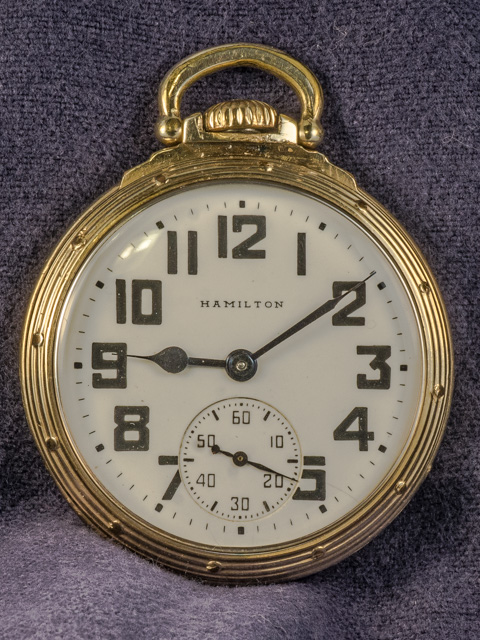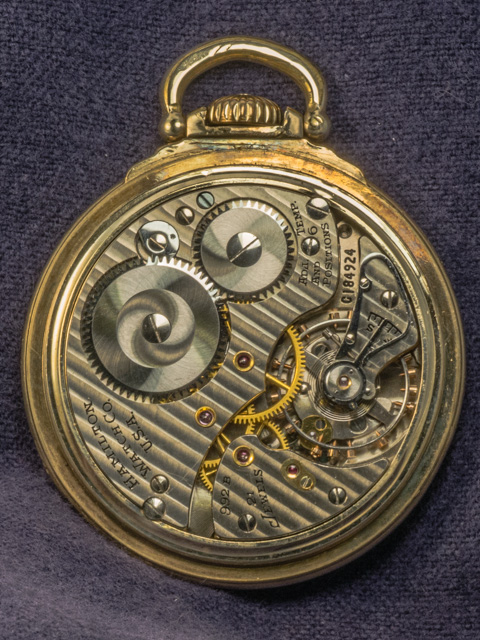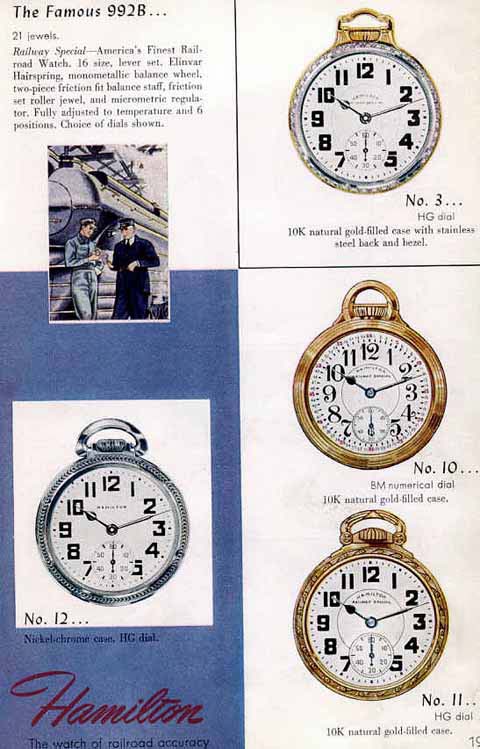
| WWT Shows | CLICK TO: Join and Support Internet Horology Club 185™ | IHC185™ Forums |

|
• Check Out Our... • • TWO Book Offer! • |
Welcome Aboard IHC185™  Internet Horology Club 185
Internet Horology Club 185  IHC185™ Discussion Site Main Page
IHC185™ Discussion Site Main Page  Open to the World RESEARCH FORUMS
Open to the World RESEARCH FORUMS  Hamilton and 992B Research Forum
Hamilton and 992B Research Forum  Learning About my new 992B
Learning About my new 992B
 Internet Horology Club 185
Internet Horology Club 185  IHC185™ Discussion Site Main Page
IHC185™ Discussion Site Main Page  Open to the World RESEARCH FORUMS
Open to the World RESEARCH FORUMS  Hamilton and 992B Research Forum
Hamilton and 992B Research Forum  Learning About my new 992B
Learning About my new 992BGo  | New Topic  | Find-Or-Search  | Notify  | Tools  | Reply to Post  |  |
Hello to all, This being my first posting on this site, I wanted to introduce myself. My main interest for the last 55 years has been amateur astronomy. But I have also been interested in clocks for a long time, mostly just reading about the history of time-keeping. But I wanted to learn a little bit more about my "new" Hamilton 992B. This forum has been a gold mine of information. But I haven't noticed anywhere the metallic composition of the balance wheel. I know the hairspring is Elinvar Extra. But is the balance wheel the same or perhaps Invar? My 992B is no. C184924. I'll be posting some photos soon. My Hamilton 992B adventure started when I began researching a 1925, 17-jewel Elgin pocket watch that had been my grandfather's. He died before I was born. Many years later the watch was given to me by my uncle. My wife noticed I was researching pocket watches and gave me another watch, which ended up being the 992B. At first I wasn't particularly interested in it since it wasn't really a family heirloom. A Navy buddy of my uncle owned him some money, eventually paying with the watch. My uncle gave my wife that watch the same time he gave me grampa's watch. I had forgotten. Yeah, it seemed like a nice watch, but in my ignorance I assumed it needed repair since I couldn't set the time with the stem. But thanks to this forum I learned how to open the case and use the lever to enable setting the watch. I took note of the markings on the movement. The more I learned about the watch, the more I came to appreciate its value. No, it's not rare, but certainly one of the better watches of its era. I've been testing its daily rate. At first it was losing a few (2-5) seconds a day. But then it began gaining time finally settling on a rate of +9.0 seconds per day. This brings up a question: Is the above behavior of changing daily rate the result of some old gummed up lubricant finally becoming a bit less gummy (i.e. more slick)? It took about a week before it settled on the 9-second rate. When I get my light box set up I hope to take some photos of the movement. When the case is open I'll adjust the micro-regulator screw a bit less than 1/2 turn in the slow direction. Another 10 days in measuring the daily rate will tell me if this has improved things. Thanks for any help and advice forum members can give. Best Regards, Russ | |||
|
Russel, Welcome to the club. Try doing a google search for "Hamilton aurium" to get some answers on the balance wheel question. Before you adjust the watch you may want to try running it in different positions such as face up, face down, and pendant up if you haven't already. It's probably worthwhile to have the watch cleaned, oiled, and adjusted if you plan on using it more than occasionally. Looking forward to seeing some pictures. RR | ||||
|
Hi Richard, Thanks for the reply and suggestions. I've gotten a few photos of my 992B which will be shared. When the case was open I resisted the temptation to adjust the regulator. I'll follow your suggestion to test the watch's rate in different positions. Next I'll test in Pendant-up orientation to see how it does. Best Regards, Russ  | ||||
|
Hi Richard, The first photo shows the dial has a fine crack through the number 5. Also the crown is a bit askew. Both the crown and bow are a bit loose. The second photo below shows the movement. Best Regards, Russ  | ||||
|
Russel, Nice watch, looks entirely correct. Movement from 1947 when the Model A shouldered version was coming to an end. Hamilton Case Question "Shouldered". You can confirm the case number here: KEYSTONE-HAMILTON CASE A, 11, 14 AND 17 DATABASE EXAMPLES YEAR-BY-YEAR The 080 SS porcelain-enamel dial was advertised on the Model 12 case in 1946 (See below) and it's correct for 1947. Hamilton started phasing in melamine dials approximately a year (1948) after your watch was produced. Melamine dials aren't as durable as porcelain-enamel and many are no longer usable. Correct matching hands. Hamilton advertisement from 1946  | ||||
|
Enjoy, RR Hamilton dealer catalog from 1948 illustrating a Model A cased 992B with the 080 dial  | ||||
|
| IHC Life Member |
Russell, welcome to the best club in the world to learn about these great railroad pocket watches. You have a really nice Hamilton Railroad pocket watch there. One of the BEST!! I guess I wouldn't worry to much about the timing until it has a good COA = Clean Oil and Adjust. You will find that once it is cleaned it will require different adjustments to get it timed again anyway. For a 70 year old watch 9 seconds a day is pretty good. I assume that was in the face up position. I notice that the regulator is a little to the slow side of center. that in itself could be an indicator that it is in need of service. There are some really good people here that can answer your questions, and even service your watch for you if you decide to have it done. Good luck, and enjoy this great club! Regards, Larry | |||
|
Thanks Richard and Larry for your replies and useful information. Richard: Your link to the Keystone-Hamilton Case A was interesting. I forgot to photograph the case back. But it has the following inside: Hamilton Watch Co., Lancaster, PA; 10K (The 10 & K are on each side of a vase figure.) Gold Filled, K168706 (The last 3 digits are at an angle sloping up.) So given that information am I correct in saying mine is a Keystone-Hamilton Case A? It is nice to hear that my watch appears to be all original (including hands), correct for its year of manufacture. I was also pleased to learn that it is near the phase out of both the shouldered case and the porcelain-enamel dial. Some of those melamine dials are poor when they get very old. Richard, I have another question: In the 1948 dealer's catalog, what does it mean that a model A case is also available with a "numerical dial"? Isn't the 080 dial already numerical? Thanks for your comments and help! Larry, thanks so much for your encouragement and advice. It is amazing to me how this old watch turned out to be an exceptional model. I know many thousands were manufactured. In this forum about how many have been reported to still be in existence and working? I'll follow the advice given by yourself and Richard to get a COA when I get done checking its rate. Since I already have checked its rate face up, I wanted to try checking the rate pendant up. I'll refrain from making any adjustments myself. From the looks of the worn screw heads and scratches on the movement, I assume it has been serviced in the past. How long ago is anyone's guess. Does a standard COA include adjusting to factory specs? Would that include adjusting the balance wheel weights and timing with one of those timing meters (I don't know the correct term)? Any suggestions in finding a good place to get a COA? Many thanks to both Richard and Larry for your kind comments, information and suggestions! Best Regards, Russ | ||||
|
| IHC Life Member |
Russell, The standard COA does include adjusting the timing but I have found that few watchmakers, and I mean "watchmakers", will really take the time to adjust them to the original factory timing specks. The reason is because it is VERY involved, takes a LOT of time, and can be very costly. To get one of these to the factory specks can mean replacing worn parts like pivots, jewels, springs, and who knows what else. I have done MANY of the 992B's and it is not uncommon at all to have one, after a good cleaning, run really close to factory specks. Maybe one or two positions will be out just a little more than what is allowed, but other than that it will be right on. The problem is when a novice starts adjusting the timing screws on the balance wheel and really throws everything off. To a person like myself who has just a basic knowledge of them it would be almost impossible to get it back in the proper adjustments. I was taught by one of the best watchmakers in the business with over 50 years experience. The most important thing I learned was to know enough to stay way from something as complicated as that. Yes I can time them by using the timing screws, but only after many hours of his tutoring, BUT,... to put one back in time after someone has gone in and really messed it up would not be something I could do. In fact this watchmaker will not even do it anymore. I will adjust one to within 5+ seconds a day face up, or if I know someone is going to carry, say pendent up, and pendent left. Your 992B is arguably one of the best timekeepers in the world, so I would say that it will come in pretty close. There are a FEW good people here who can do a really good job of servicing your watch. I will let them introduce themselves to you, and then you can decide. They are all good at their craft here! Regards, Larry | |||
|
Thanks Larry, for the interesting information. When I finish checking the watch's current rate for face-up, face-down and pendant-up it will get a COA. I don't expect to have anyone expend a lot of effort and expense in adjusting the balance wheel. Just having a decent rate in pendant-up would be fine with me. I do want it cleaned and lubed so that it will not adversely wear. The watch might be used infrequently on special occasions. So railroad accuracy is not an issue. I would like the bow and crown tightened up especially if there's any danger of them separating from the case. It would be unfortunate if the watch would drop if the bow lets loose. It's just too nice of a timepiece to have that happen. It is very interesting learning about my "new" 992B and other old timepieces. These are the pinnacle of micro-mechanical ingenuity and fabrication/construction skills. Yes, from a bygone era, but still quite fascinating to research. Best Regards, Russ | ||||
|
Russel, I would describe your watch as a Hamilton Model A case 992B with a 080 Heavy Gothic dial. Hamilton used the term "numerical" to refer to their dials with every minute marked. Hamilton started advertising as "safety numerical dial" and eventually eliminated the word safety. The 1946 ad above illustrates a No. 10 992B with a Blind Man Numerical dial. You can find Hamilton dial information here: For Your Information... RR | ||||
|
Richard, thanks so much for your reply. I've been checking the watch's rate pendant-up, and it's a bit improved over face-up. Most days it has been running 1 to five seconds. Strangely after one day gaining just 1 second, the following day it was off by 11.5 seconds. So it's time for a COA. I have located a local watch repair/service man with over 40 years in the business. Since he's just 26 miles away, I'll deliver the watch to him next week for COA service. It will be nice to meet the watch man face to face. Best Regards, Russ | ||||
|
| Powered by Social Strata |
| Your request is being processed... |
|
©2002-2025 Internet Horology Club 185™ - Lindell V. Riddle President - All Rights Reserved Worldwide

